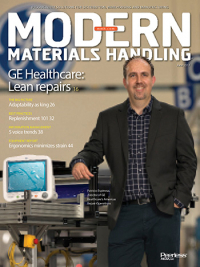Lift Truck Tips: Fleet purchasers cozy up to ergonomic features
Some ergonomic features are basics verging on standard and others are becoming more requested.
It’s a straightforward principle, if a bit difficult to measure: the more comfortable a forklift operator, the greater their productivity and satisfaction. Then again, it’s business, and although the best is ideal, everything comes at a price.
Yet, the price for things like armrest mini lever controls, customized seats and engineered computer mounts seems to be worth it, even when compared to the sometimes uncertain costs of fatigue, retention, injury and safety in general.
“We’re starting to see that people are actually interested in putting ergonomic items into trucks,” says Mark Faiman, product manager of IC, AWP and GSE products for Toyota Material Handling, U.S.A. “It used to be that we would offer them, but it would come down to cost and the customer would often settle with basic features.”
Some ergonomic features are basics verging on standard, like grips on overhead guards that ease the act of looking and driving backwards. Faiman notes these are lately enjoying “extremely high sales rates.” Other high-tech features, due to reduced component costs, are also creeping toward entry-level forklifts.
“As electronic controls develop more and more in our industry, they allow manufacturers to free up space,” Faiman says. “Even on smaller three-wheel trucks we’re seeing electronic steering assemblies, hydraulic controls, and armrest-style control levers. It’s an expanding trend, and will eventually result in a sort of dashless truck with much more visibility.”
In the meantime, forklift users are not just taking a passive interest in enhancing operator comfort. Faiman says customers are increasingly submitting very detailed specifications, including requests for special designs and customization.
“With the seat, for instance, they want to know how much padding, what kind of suspension, what material is the seat covered with,” he says. “They want mobile computers fully set up to match exact specs for accessibility and visibility. One customer sent us 17 pages of requests. They weren’t all ergonomic features, but it shows the high level of customization.”
Many customers seem to be aiming squarely at retention with their ergonomic requests, many of which are based on feedback from experienced operators. The resulting productivity boosts are the icing on the cake.
“They’re finding the extra mile helps out a lot,” Faiman says, adding that technology is not done transforming the daily lives of forklift operators. “The next frontier of ergonomics and lift trucks in general is the self-driving vehicle phase. It will be very interesting to see how that plays out.”

Article Topics
Columns News & Resources
New resource center for weighing and dimensioning Protective packaging roundup MODEX C-Suite Q&A: Troy Donnelly, Senior VP of Sales, Marketing, and Application, DMW&H When Just-in-Time Just Doesn’t Work Recycling coastline plastic into premium reusable packaging Fresh food, anyone? RPCs protect in the supply chain Why Isn’t Your Loading Dock Connected to Your Supply Chain? More ColumnsLatest in Materials Handling
Registration open for Pack Expo International 2024 Walmart chooses Swisslog AS/RS and software for third milk processing facility NetLogistik partners with Vuzix subsidiary Moviynt to offer mobility solutions for warehouses Materials Handling Robotics: The new world of heterogeneous robotic integration BSLBATT is looking for new distributors and resellers worldwide Lucas Watson appointed CSO for Körber’s Parcel Logistics business in North America Hyster recognizes Dealers of Distinction for 2023 More Materials HandlingAbout the Author
Subscribe to Materials Handling Magazine

Find out what the world's most innovative companies are doing to improve productivity in their plants and distribution centers.
Start your FREE subscription today.
April 2024 Modern Materials Handling

Latest Resources












